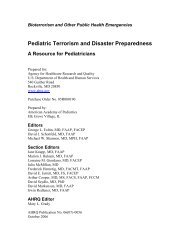H1N1 COUNTERMEASURES STRATEGY AND ... - PHE Home
H1N1 COUNTERMEASURES STRATEGY AND ... - PHE Home
H1N1 COUNTERMEASURES STRATEGY AND ... - PHE Home
Create successful ePaper yourself
Turn your PDF publications into a flip-book with our unique Google optimized e-Paper software.
NBSB Pandemic Influenza Working Group<br />
Detailed Report<br />
Dr. Hayden listed a number of anti-influenza agents that are being investigated. A March<br />
2009 meeting of NIAID, BARDA, and others focused on new agents (the meeting<br />
summary is available), including host-directed approaches. There is potential for<br />
development of topical single-dose CS8958; it is in phase-2 trials, but no data have yet<br />
been reported. One new agent by Toyama, Favipiravir (T-705), targets polymerase. It<br />
has better in-vitro activity than ribavirin. Phase-2 trials of efficacy have been completed<br />
in Japan. The drug appears to have oral bioavailability, and Dr. Hayden called it<br />
interesting. The other drugs are all in phase-1 trials, and delivery issues are being<br />
addressed.<br />
Of the new agents, several have antibodies that target group-1 hemagglutinins. There is<br />
potential inhibition by monoclonals that direct to specific areas. Model data show doserelated<br />
improvements in survival and efficacy.<br />
Conducting clinical studies in hospitalized patients is very hard, Dr. Hayden noted. More<br />
effective diagnostic tools are needed. Hospitalized patients are a heterogeneous group;<br />
they have co-morbidities, co-infections, concomitant therapy, variable disease courses<br />
and pathogenesis, and many have exacerbation of underlying disease. Researchers face<br />
recruitment and trial design hurdles, e.g., getting informed consent from impaired<br />
patients, determining inclusion and exclusion criteria to get generalized data, and<br />
incorporating changing standards of care. According to the FDA draft document out for<br />
comment, investigators need to closely consider the endpoints of their studies. Also,<br />
there is a lack of experienced investigators and staff.<br />
A study in hospitalized patients is trying to address the issue of endpoints. It is a<br />
randomized, controlled trial comparing oseltamivir and peramivir, which measures time<br />
to clinical stability and time to return to daily activity.<br />
Dr. Hayden summarized the issues of concern for antiviral treatment:<br />
<br />
<br />
<br />
Medical need exists for parenteral agents for seriously ill patients, novel agents<br />
with new antiviral spectra, and new agents with less frequent dosing<br />
requirements.<br />
SNS diversification is warranted.<br />
Realistic development pathways are needed for new agents, especially<br />
combination therapy for hospitalized patients. Development would be enhanced<br />
by use of endpoints that are antiviral-oriented and a domestic hospital-based<br />
network for severe acute respiratory illness (SARI) studies.<br />
Dr. Pavia commented that progress on new antiviral agents has been distressingly slow<br />
despite all the attention to pandemic influenza in the past 5 years.<br />
GSK Zanamivir Strategy and Response to Novel <strong>H1N1</strong>— Judith Ng-Cashin, M.D.<br />
Dr. Ng-Cashin said GSK recognizes the need for antivirals and is working to deploy its<br />
existing stockpile supplies, and rapidly maximize its production of its approved product,<br />
Relenza Rotadisk/Diskhaler. GSK is also investing in an alternative strategy to increase<br />
71
















